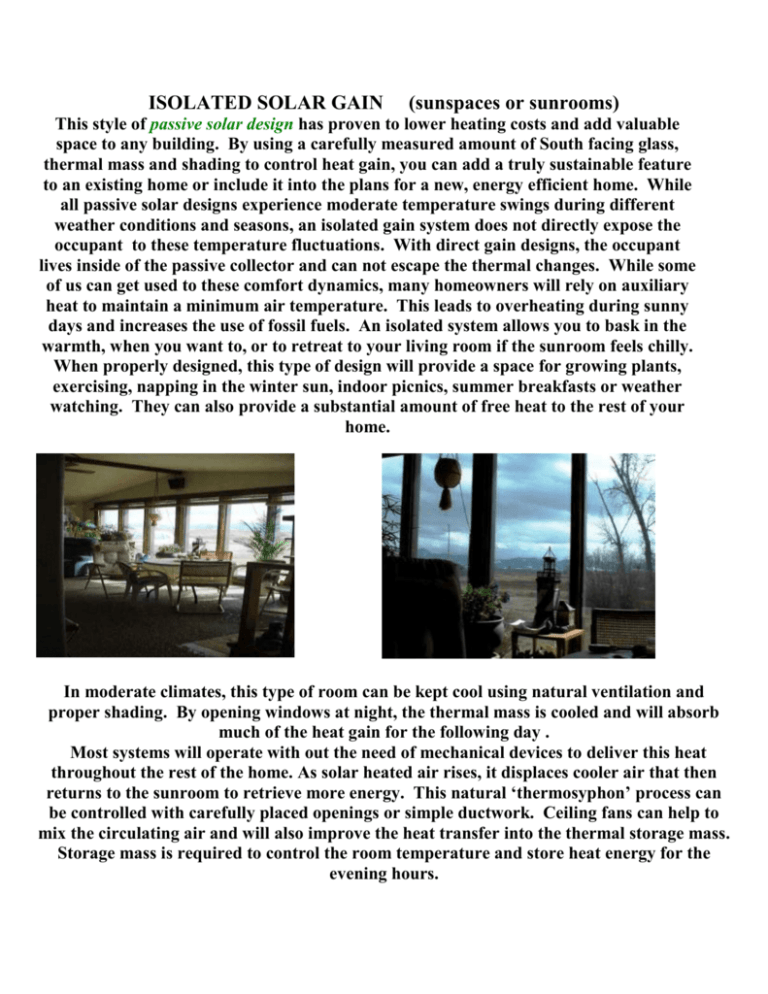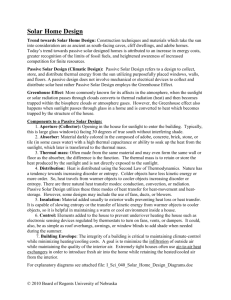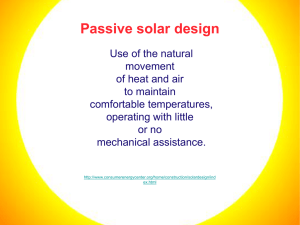ISOLATED SOLAR GAIN FOR HOMES
advertisement

ISOLATED SOLAR GAIN (sunspaces or sunrooms) This style of passive solar design has proven to lower heating costs and add valuable space to any building. By using a carefully measured amount of South facing glass, thermal mass and shading to control heat gain, you can add a truly sustainable feature to an existing home or include it into the plans for a new, energy efficient home. While all passive solar designs experience moderate temperature swings during different weather conditions and seasons, an isolated gain system does not directly expose the occupant to these temperature fluctuations. With direct gain designs, the occupant lives inside of the passive collector and can not escape the thermal changes. While some of us can get used to these comfort dynamics, many homeowners will rely on auxiliary heat to maintain a minimum air temperature. This leads to overheating during sunny days and increases the use of fossil fuels. An isolated system allows you to bask in the warmth, when you want to, or to retreat to your living room if the sunroom feels chilly. When properly designed, this type of design will provide a space for growing plants, exercising, napping in the winter sun, indoor picnics, summer breakfasts or weather watching. They can also provide a substantial amount of free heat to the rest of your home. In moderate climates, this type of room can be kept cool using natural ventilation and proper shading. By opening windows at night, the thermal mass is cooled and will absorb much of the heat gain for the following day . Most systems will operate with out the need of mechanical devices to deliver this heat throughout the rest of the home. As solar heated air rises, it displaces cooler air that then returns to the sunroom to retrieve more energy. This natural ‘thermosyphon’ process can be controlled with carefully placed openings or simple ductwork. Ceiling fans can help to mix the circulating air and will also improve the heat transfer into the thermal storage mass. Storage mass is required to control the room temperature and store heat energy for the evening hours. Cool air enters from Sunlight is converted to heat energy and Heated air rises into lower level of home raises the thermal mass and air temperature. the main living space. Heated air flows to the upper level Cooler air enters from lower level The sunspace pulls cooler air from the lower level and heats it with solar energy. The warmed air rises to the second floor and pushes slightly cooler air back to the lower level and begins the process again. Natural heat transfer can be accomplished with careful placement of openings. This must be part of the SOLAR DESIGN, along with window sizing, overhang widths and thermal mass volume. The indoor temperatures of an isolated gain space will fluctuate. While this is not a problem for plants, humans tend to be most comfortable at an indoor temperature between 65 and 75 degrees Fahrenheit. As with radiant floor heat, the thermal mass floor of the space is warm and occupants can still feel comfortable at much lower air temperatures. The following chart shows temperature swings from the passive solar home, shown above. You will see that the outdoor highs ranged from 82 to 25 *F with lows between 50 and 10 (burr). The sunroom temps ranged from 78 to 61 degrees, with living space temps between 68 and 74 degrees Fahrenheit. Note the response of the passive system in relation to solar radiation. Location: Bozeman, Montana September 28, 2009 to October 28, 2009 Dark Blue: Outside temperature Red: Solar room temperature Yellow: solar gain Green: Inside temperature Auxiliary heat was turned on for the season on October 6th. Before that time, we were using nighttime cooling to offset the unseasonably high temperatures for September in Montana. Record highs were recorded during a time when the fixed shading was designed to allow more sunlight and energy into the building. This is a very good reason to have moveable insulation or shading in any passive solar design. While thermal mass absorbs a predicted amount of daily heat gain, it is not a user adjustable component to a passive solar home. You need to rely on ventilation to remove unwanted heat or shading to decrease the amount of energy that enters your passive solar, to manage unseasonable weather events.






